Automotive Passive Electronic Components Market Size
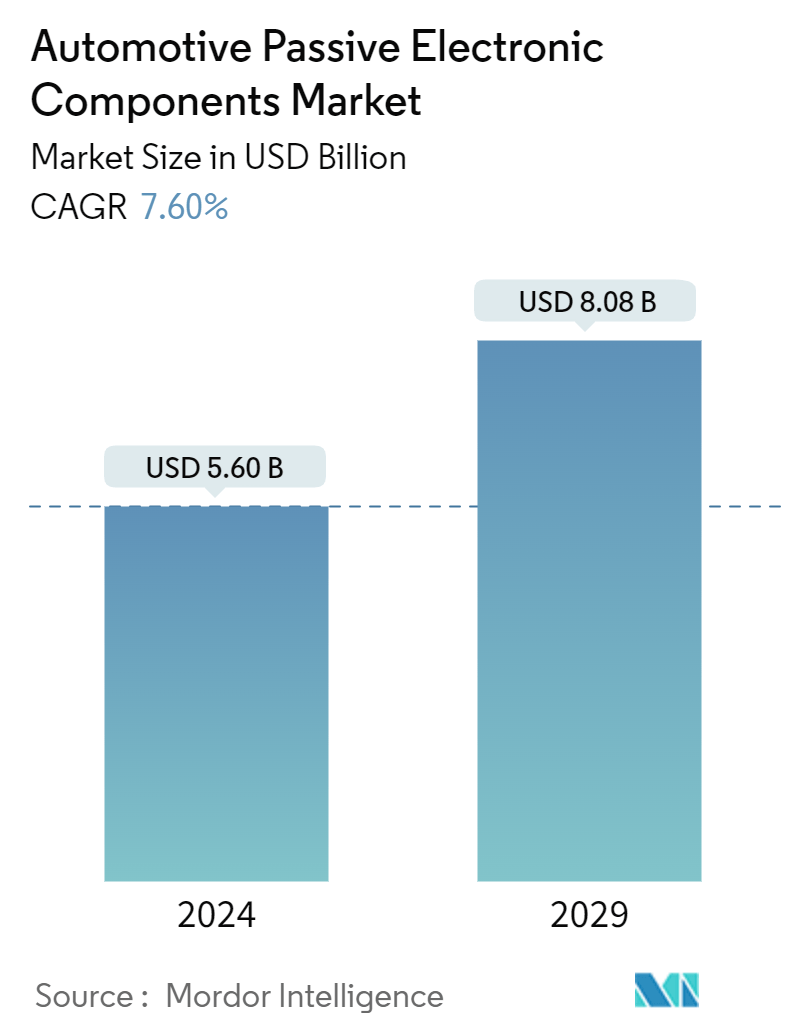
| Study Period | 2019 - 2029 |
| Market Size (2024) | USD 5.60 Billion |
| Market Size (2029) | USD 8.08 Billion |
| CAGR (2024 - 2029) | 7.60 % |
| Fastest Growing Market | Europe |
| Largest Market | Asia Pacific |
Major Players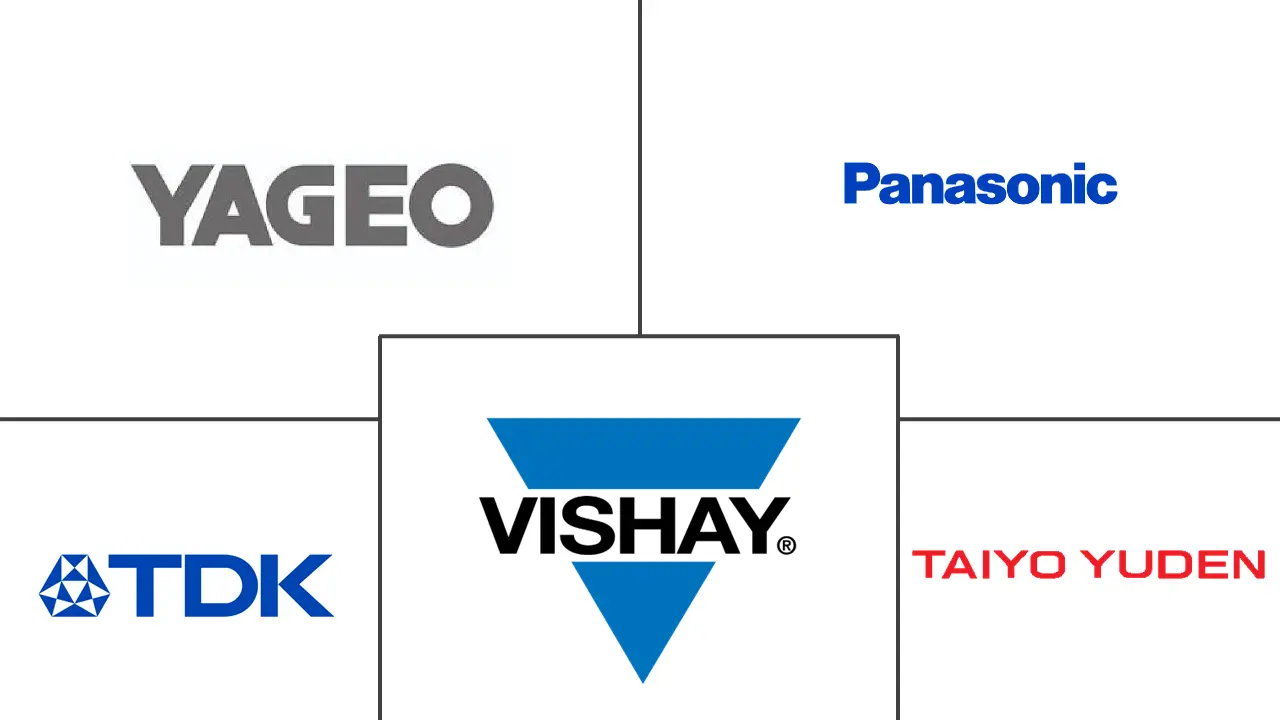
*Disclaimer: Major Players sorted in no particular order |
Automotive Passive Electronic Components Market Analysis
The Automotive Passive Electronic Components Market size is estimated at USD 5.60 billion in 2024, and is expected to reach USD 8.08 billion by 2029, growing at a CAGR of 7.60% during the forecast period (2024-2029).
- The automotive industry is leading the way in the increasing need for passive components. The demand for electronic vehicle systems is rising for various uses, such as electronic control units (ECUs) under the hood, infotainment systems, and advanced driver assistance systems (ADASs). Automotive electronic systems require high-quality components to guarantee dependable performance, like capacitors for filtering and storing energy, varistors for circuit protection, connectors for small ECUs, and RF and microwave passive components and antennas for connectivity support.
- Automobile manufacturers increasingly integrate electronic components into traditional combustion engine vehicles to enhance fuel efficiency, reduce emissions, and improve overall vehicle performance. This trend drives the demand for passive electronic components like resistors, capacitors, and inductors. For instance, according to SIAM India, during the fiscal year 2023, more than 3.89 million passenger vehicles were sold in the domestic market.
- ADAS (advanced driver assistance systems), such as collision avoidance systems and adaptive cruise control, rely heavily on passive electronic components like capacitors for sensor signal processing, filtering, and data transmission. Modern vehicles feature advanced infotainment systems, telematics, and connectivity solutions that require passive components for wireless communication, signal processing, and data transmission.
- As automotive electronics become more compact and integrated, passive components must meet increasingly stringent size and weight requirements. Miniaturization challenges, such as maintaining performance while reducing package size, can limit market growth. In addition, designing and manufacturing automotive-grade passive electronic components require significant research, development, and testing. High development costs limit innovation in the market.
- Environmental concerns, including sustainability and climate change, influence automotive industry trends and regulations. Growing emphasis on ecological sustainability may drive the adoption of vehicles' energy-efficient and environmentally friendly electronic components. Moreover, trade policies, tariffs, and trade agreements can impact the cost and availability of automotive components. Changes in trade policies may disrupt supply chains, affect pricing, and influence market competition.
Automotive Passive Electronic Components Market Trends
Capacitors to Witness Significant Growth
- Advancements in capacitor technology have led to the development of smaller, lighter, and more efficient capacitors. This enables automotive manufacturers to design compact and lightweight electronic systems, reducing overall vehicle weight and improving fuel efficiency. The increasing adoption of ADAS (advanced driver assistance systems), infotainment systems, and automobile connectivity features require robust and reliable electronic components. Capacitors support implementing these features by providing a stable power supply and ensuring the smooth operation of sensors, cameras, and communication modules.
- For instance, in August 2023, TDK Corporation in India (Nasik) was set for business prospects as it has enhanced its capacity. This specific facility in Nashik is growing its production capabilities and has introduced a new structure spanning approximately 23,000 square meters. In the coming four years, more production lines will be established for DC capacitors used in automotive sectors. These capacitors will be manufactured for the local market in India and overseas export. The increase in capacity creates new prospects that will support the company's medium-term growth strategy.
- Stringent government regulations and fuel economy standards drive the demand for energy-efficient automotive systems. Capacitors help optimize energy usage and minimize power losses, aligning with regulator requirements and sustainability goals. Capacitors are integral to the functioning of automotive electronic systems, and the demand is expected to continue growing as vehicle electrification, connectivity, and automation trends accelerate.
- For instance, in May 2024, Hyundai Motor Co. planned to utilize the investment already set aside for the United States to manufacture hybrid vehicles at its EV plant. The third-largest automaker globally, along with affiliate Kia Corp, intends to use funds allocated for EV and battery manufacturing facilities in Georgia to produce hybrid cars. Hyundai Motor Group of South Korea, which includes Hyundai Motor and Kia, announced plans to invest USD 12.6 billion in building new electric vehicle and battery production plants in Georgia, marking its most significant investment outside of South Korea.
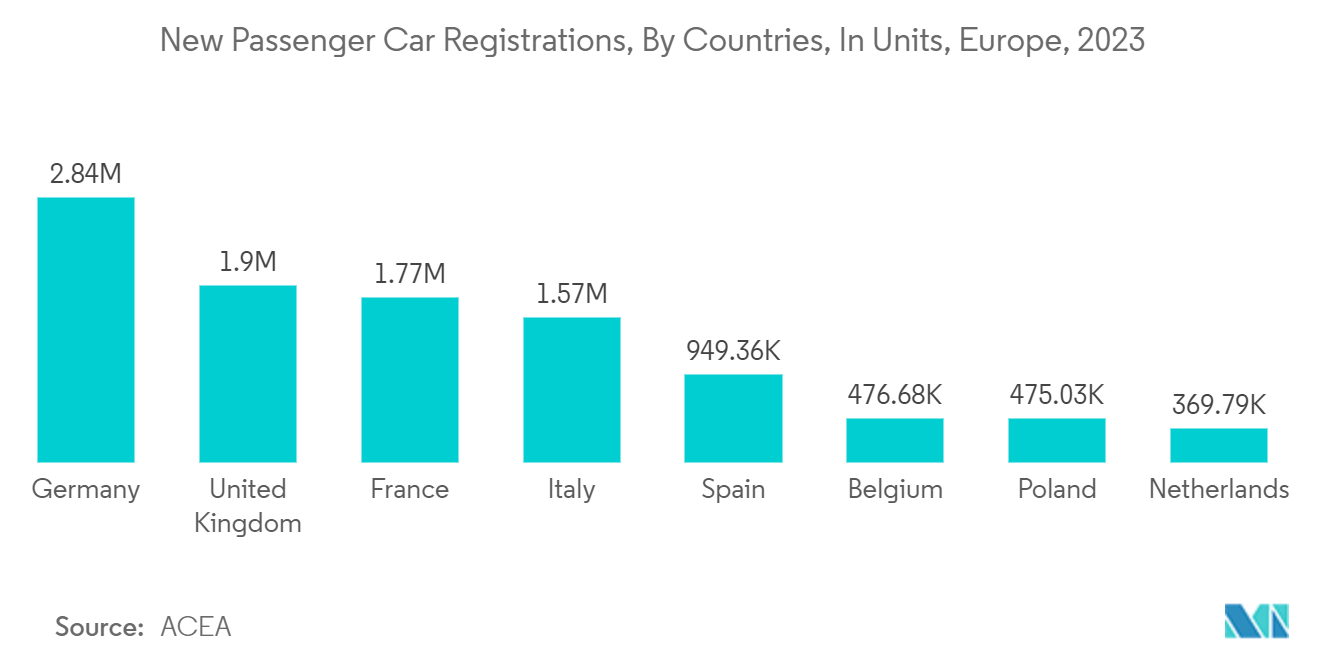
Europe to Hold Significant Market Share
- Europe is home to some of the world's largest automotive markets, including the United Kingdom, Germany, and France. Europe accounts for a significant portion of worldwide vehicle production and sales. The rising demand for commercial and passenger vehicles in these countries contributes to the market for passive electronic components used in various automotive systems.
- Europe is experiencing rapid growth in the adoption of electric vehicles (EVs), battery electric vehicles (BEVs), and hybrid electric vehicles (HEVs). European government incentives and technological advancements are driving the shift toward electrified powertrains. This transition increases the demand for passive electronic components such as capacitors, inductors, and resistors used in electric drivetrains, battery management systems, and onboard electronics. For instance, in 2023, electric cars, including both BEV and PHEV, accounted for approximately 4.8& of passenger cars in Germany, as reported by KBA. The proportion of electric vehicles has steadily risen each year within the specified time frame, particularly for BEV models.
- The automotive industry in European countries like the United Kingdom, Germany, and France is at the forefront of innovation, strongly focusing on developing advanced vehicle technologies. This includes the integration of smart features, connectivity solutions, and ADAS. These technologies require various passive electronic components to support functions such as vehicle networking.
- For instance, in November 2023, the United Kingdom government allocated EUR 150 million (USD 189 million) as part of a larger EUR 4.5 billion (USD 5.7 million) investment to support British manufacturing and stimulate economic expansion. This funding is aimed at the connected and automated mobility (CAM) sector up to 2030. The budget allocated to help CAM will be supplemented by industry contributions, which will allow the United Kingdom's Centre for Connected and Autonomous Vehicles (CCAV) to solidify the UK's position as a global leader in the creation, advancement, implementation, and production of self-driving technologies, products, and services.
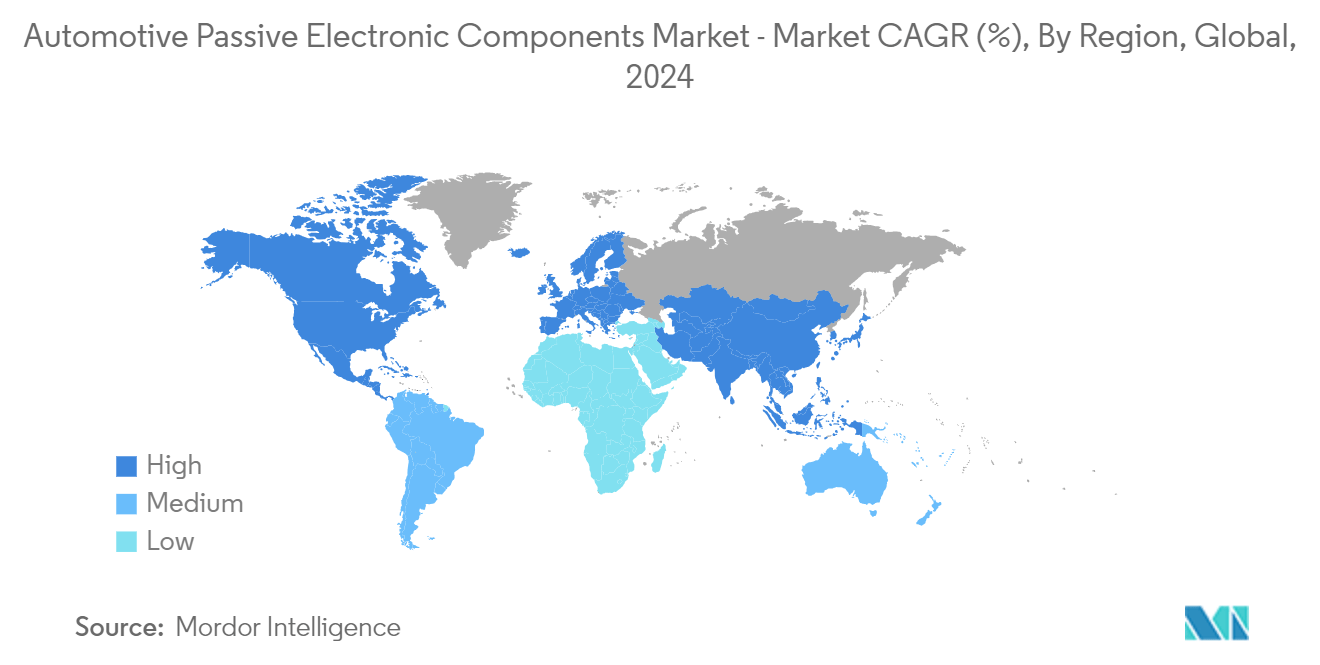
Automotive Passive Electronic Components Industry Overview
The automotive passive electronic components market is very competitive. The market is highly concentrated due to various small and large players. All the major players account for a significant market share and focus on expanding the global consumer base. Some significant players in the market are Yageo Corporation, Panasonic Corporation, TDK Corporation, Vishay Intertechnology Inc., Taiyo Yuden Corporation, and many more. Companies are increasing their market share by forming multiple collaborations, partnerships, and acquisitions and investing in introducing new products to earn a competitive edge during the forecast period.
March 2024: JF Kilfoil Company expanded its representation of Knowles' products to include the Cornell Dubilier brand in the Midwest market. This partnership was established due to Knowles' acquisition of Cornell Dubilier, which allowed the company to offer a broader range of film, electrolytic, and specialty capacitors. The product range comprises single-layer capacitors, trimmers, aluminum electrolytic capacitors, aluminum polymer capacitors, film capacitors, mica capacitors, and supercapacitors. These items are known for their reliability, longevity, and excellent performance in challenging situations.
September 2023: Knowles Precision Devices acquired Cornell Dubilier for USD 263 million in cash. This acquisition will include film, electrolytic, and mica capacitor products and is anticipated to enhance non-GAAP EPS by 2024. Cornell Dubilier's diverse range of power film, electrolytic, and mica capacitors, combined with Knowles' Precision Devices segment, will offer a valuable proposition and expanded product portfolio to current and potential customers.
Automotive Passive Electronic Components Market Leaders
-
Yageo Corporation
-
Panasonic Corporation
-
TDK Corporation
-
Vishay Intertechnology Inc.
-
Taiyo Yuden Corporation
*Disclaimer: Major Players sorted in no particular order
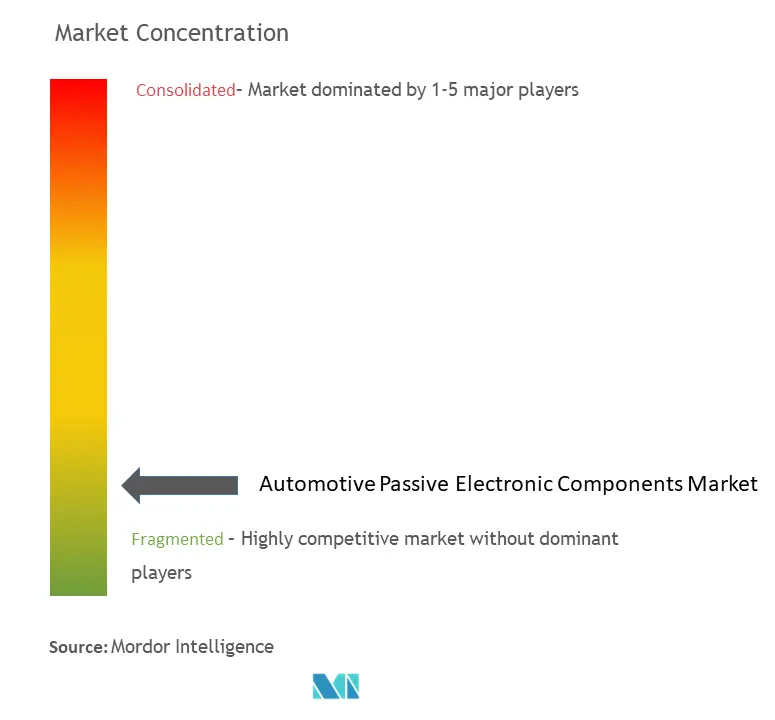
Automotive Passive Electronic Components Market News
- March 2024: Knowles Precision Devices, a provider of top-quality components and solutions, released its newest Electric double-layer capacitor (EDLC) modules, also known as supercapacitor modules. These advanced capacitors, constructed using Knowles' Cornell Dubilier brand DGH and DSF Series supercapacitors, come in a three-cell package for increased operating voltages and save space on printed circuit boards. The high capacity of these supercapacitors enables them to support additional batteries or even replace batteries in various applications. These supercapacitors are well-suited for providing power for electric vehicle transportation, powering pulse battery packs, creating battery/capacitor hybrids, or any situation requiring substantial energy storage.
- February 2024: Taiyo Yuden Co. Ltd announced the completion of a material building to manufacture barium titanate, a raw material of multilayer ceramic capacitors, at the Yawatabara Plant (Takasaki-shi, Gunma, Japan). The building has a total floor area of approximately 20,500 square meters and a building area of approximately 6,600 square meters. Taiyo Yuden is focused on creating electronic components to enhance electronic devices and is committed to providing customers with a consistent and timely supply.
Automotive Passive Electronic Components Market Report - Table of Contents
1. INTRODUCTION
- 1.1 Study Assumptions and Market Definition
- 1.2 Scope of the Study
2. RESEARCH METHODOLOGY
3. EXECUTIVE SUMMARY
4. MARKET INSIGHTS
- 4.1 Market Overview
-
4.2 Industry Attractiveness - Porter's Five Forces Analysis
- 4.2.1 Threat of New Entrants
- 4.2.2 Bargaining Power of Buyers/Consumers
- 4.2.3 Bargaining Power of Suppliers
- 4.2.4 Threat of Substitute Products
- 4.2.5 Intensity of Competitive Rivalry
- 4.3 Technology Snapshot
- 4.4 Impact of COVID-19 Aftereffects and Other Macroeconomic Factors on the Market
5. MARKET DYNAMICS
-
5.1 Market Drivers
- 5.1.1 Increasing Usage of Advanced Electronic Devices in the Industry
- 5.1.2 Increasing Preference for Miniaturized Designs
-
5.2 Market Restraints
- 5.2.1 Fluctuating Prices of Critical Metals Used in Manufacturing of Passive Electronic Components/ Challenges in the manufacturing of various Passive Components
6. MARKET SEGMENTATION
-
6.1 By Type
- 6.1.1 Capacitors
- 6.1.1.1 Ceramic Capacitors
- 6.1.1.2 Tantalum Capacitors
- 6.1.1.3 Aluminum Electrolytic Capacitors
- 6.1.1.4 Paper and Plastic Film Capacitors
- 6.1.1.5 Supercapacitors
- 6.1.2 Inductors
- 6.1.3 Resistors
- 6.1.3.1 Surface-mounted Chips
- 6.1.3.2 Network and Array
- 6.1.3.3 Other Specialty
- 6.1.4 EMC Filters
-
6.2 By Geography***
- 6.2.1 North America
- 6.2.2 Europe
- 6.2.3 Asia
- 6.2.4 Australia and New Zealand
- 6.2.5 Middle East and Africa
- 6.2.6 Latin America
7. COMPETITIVE LANDSCAPE
-
7.1 Company Profiles*
- 7.1.1 Yageo Corporation
- 7.1.2 Panasonic Corporation
- 7.1.3 TDK Corporation
- 7.1.4 Vishay Intertechnology Inc.
- 7.1.5 Taiyo Yuden Corporation
- 7.1.6 Kyocera Corporation (includes AVX Corporation)
- 7.1.7 Knowles Precision Devices
- 7.1.8 Murata Manufacturing Co. Ltd
- 7.1.9 Samsung Electro-Mechanical
- 7.1.10 KOA Corporation
- 7.1.11 Rubycon Corporation
- 7.1.12 Nippon Chemi-Con Corporation
8. INVESTMENT ANALYSIS
9. FUTURE OF THE MARKET
** Subject To AvailablityAutomotive Passive Electronic Components Industry Segmentation
For market estimation, the revenue generated from the sale of automotive passive electronic components offered by various market players for a wide range of applications is considered. Market trends are evaluated by analyzing product innovation, diversification, and expansion investments. Further, advancements in inductors, resistors, and MEC filters are crucial in determining the market's growth.
The automotive passive electronic components market is segmented by type (capacitors [ceramic capacitors, tantalum capacitors, aluminum electrolytic capacitors, paper and plastic film capacitors, supercapacitors], inductors, and resistors [surface-mounted chips, network and array, and other specialty], and EMC filters)) and geography (North America, Europe, Asia-Pacific, Middle East & Africa, and Latin America). The report offers the market size and forecasts for all the above segments in value (USD).
| By Type | Capacitors | Ceramic Capacitors |
| Tantalum Capacitors | ||
| Aluminum Electrolytic Capacitors | ||
| Paper and Plastic Film Capacitors | ||
| Supercapacitors | ||
| By Type | Inductors | |
| Resistors | Surface-mounted Chips | |
| Network and Array | ||
| Other Specialty | ||
| EMC Filters | ||
| By Geography*** | North America | |
| Europe | ||
| Asia | ||
| Australia and New Zealand | ||
| Middle East and Africa | ||
| Latin America |
Automotive Passive Electronic Components Market Research FAQs
How big is the Automotive Passive Electronic Components Market?
The Automotive Passive Electronic Components Market size is expected to reach USD 5.60 billion in 2024 and grow at a CAGR of 7.60% to reach USD 8.08 billion by 2029.
What is the current Automotive Passive Electronic Components Market size?
In 2024, the Automotive Passive Electronic Components Market size is expected to reach USD 5.60 billion.
Who are the key players in Automotive Passive Electronic Components Market?
Yageo Corporation, Panasonic Corporation, TDK Corporation, Vishay Intertechnology Inc. and Taiyo Yuden Corporation are the major companies operating in the Automotive Passive Electronic Components Market.
Which is the fastest growing region in Automotive Passive Electronic Components Market?
Europe is estimated to grow at the highest CAGR over the forecast period (2024-2029).
Which region has the biggest share in Automotive Passive Electronic Components Market?
In 2024, the Asia Pacific accounts for the largest market share in Automotive Passive Electronic Components Market.
What years does this Automotive Passive Electronic Components Market cover, and what was the market size in 2023?
In 2023, the Automotive Passive Electronic Components Market size was estimated at USD 5.17 billion. The report covers the Automotive Passive Electronic Components Market historical market size for years: 2019, 2020, 2021, 2022 and 2023. The report also forecasts the Automotive Passive Electronic Components Market size for years: 2024, 2025, 2026, 2027, 2028 and 2029.
Automotive Passive Electronic Components Industry Report
Statistics for the 2024 Automotive Passive Electronic Components market share, size and revenue growth rate, created by Mordor Intelligence™ Industry Reports. Automotive Passive Electronic Components analysis includes a market forecast outlook for 2024 to 2029 and historical overview. Get a sample of this industry analysis as a free report PDF download.



